Abstract
Airway conductance was measured in a body plethysmograph at different lung volumes before and after graded exercise. In 14 out of 19 patients, mostly asthmatics, airway conductance fell significantly after exercise. These subjects also showed other signs of an increased bronchial reactivity to different stimuli, including forced breathing, hyperventilation, and cold air, but they had no exogenous allergy. The exercise-induced bronchoconstriction could be blocked by atropine in six of the nine patients tested. Exercise-induced bronchoconstriction in patients with clinical and physiological evidence of increased airway reactivity thus seems to be primarily mediated via a vagal reflex, probably from hyperresponsive airway mechanoreceptors reacting to increased ventilatory flow or lung distension. No relation was found between PaCO2 or pH and the severity of airways constriction. Cromoglycic acid failed to block the exercise reaction in five of the six hyperreactive patients tested. In addition to or following the vagal reflex a disturbed relation between beta and alpha receptors in bronchial muscles or a release of humoral spasmogens may contribute to the progression of post-exercise airways constriction.
Full text
PDF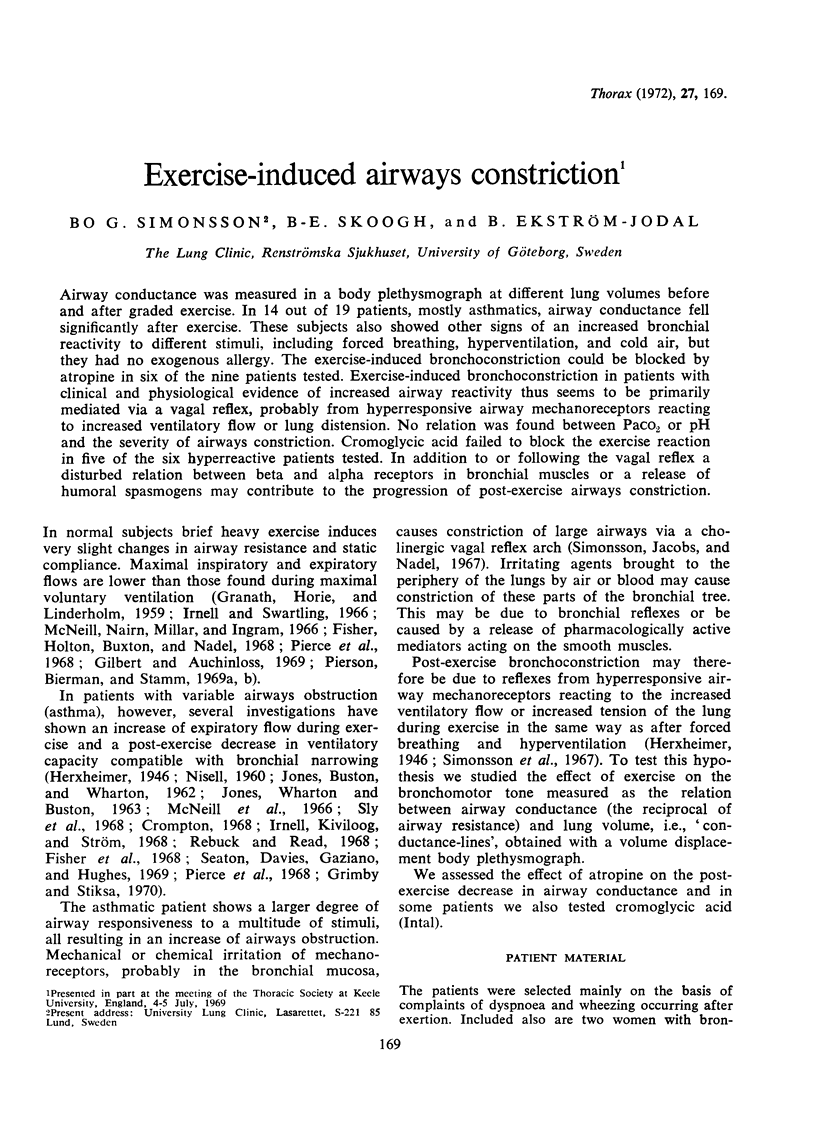
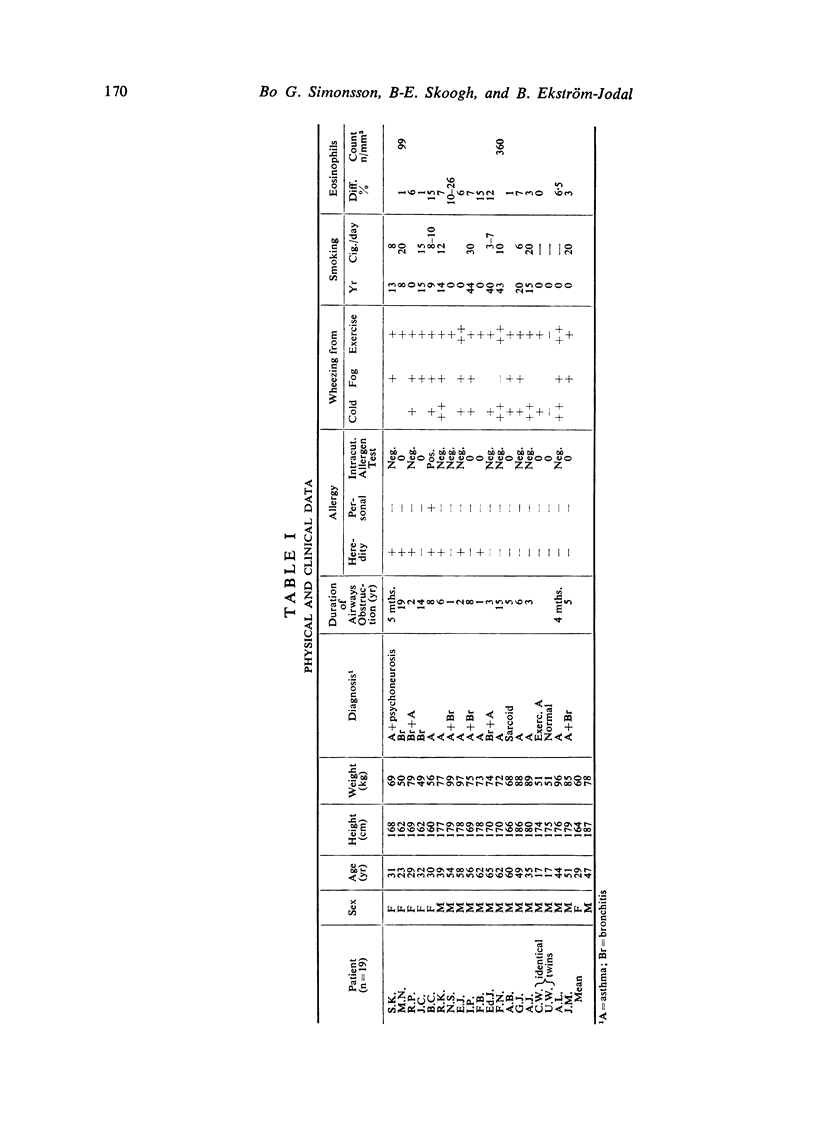
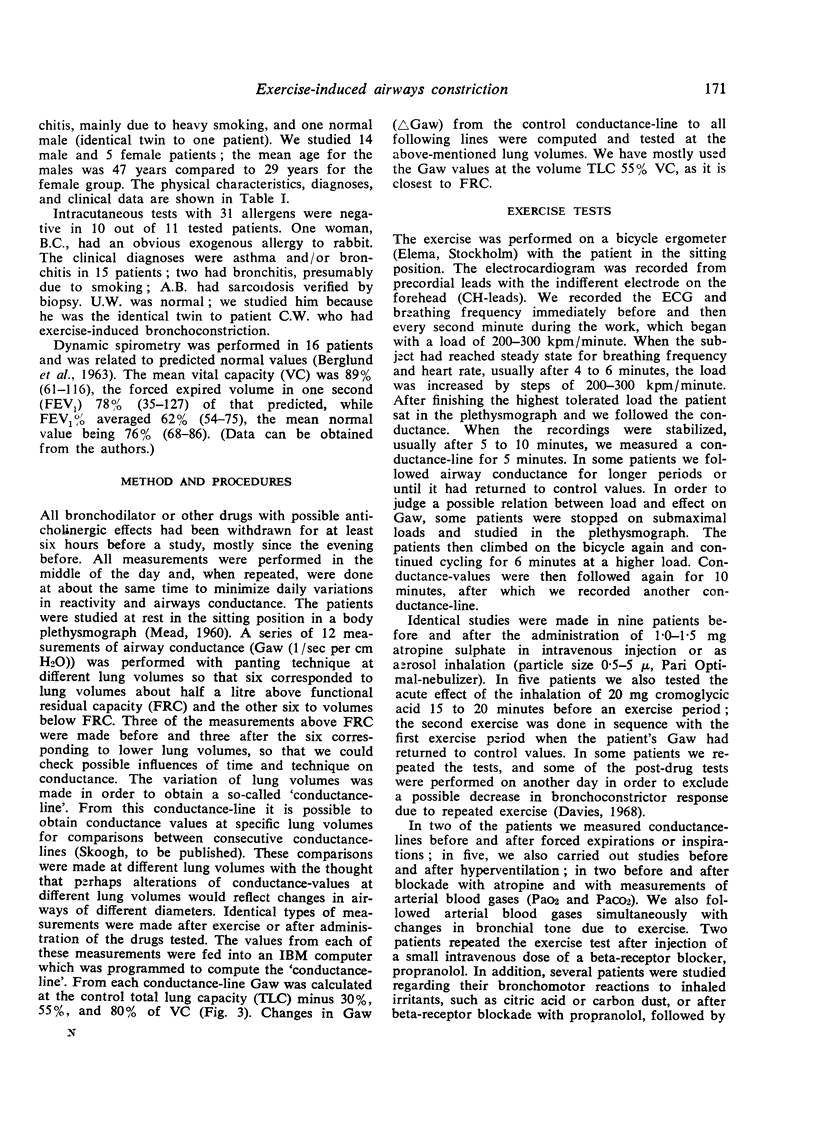
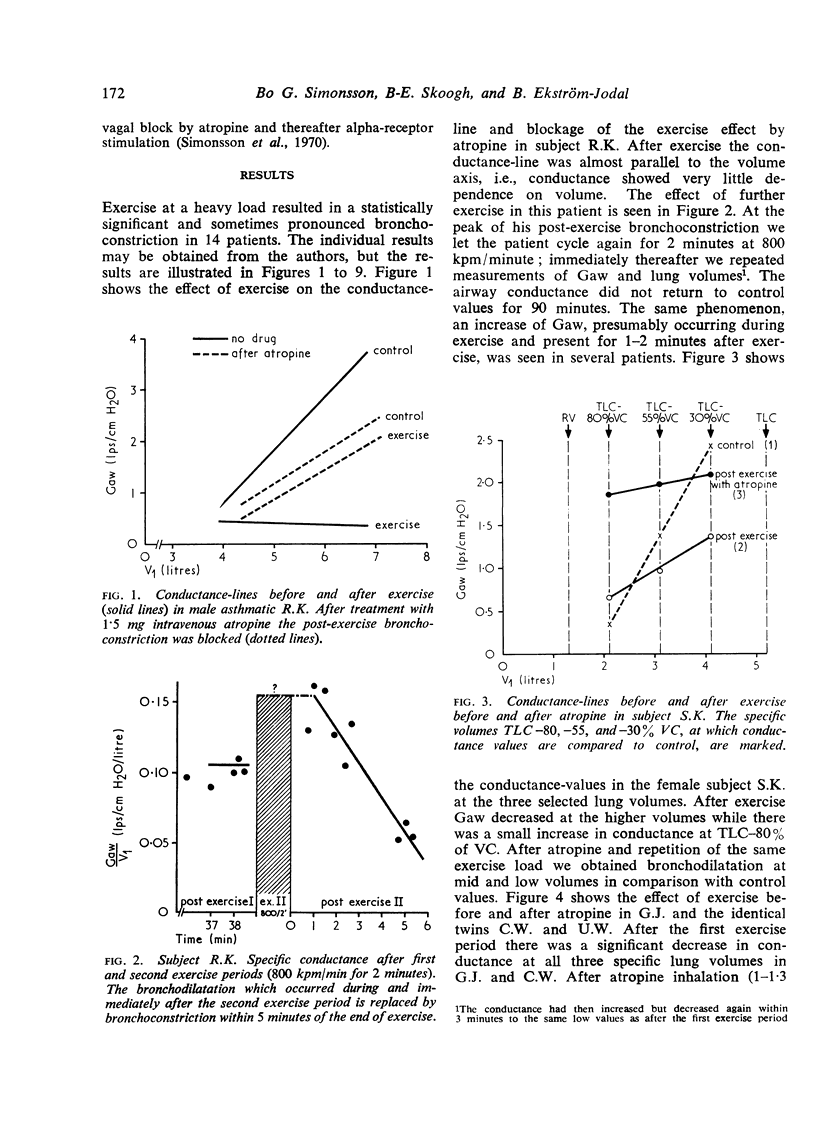
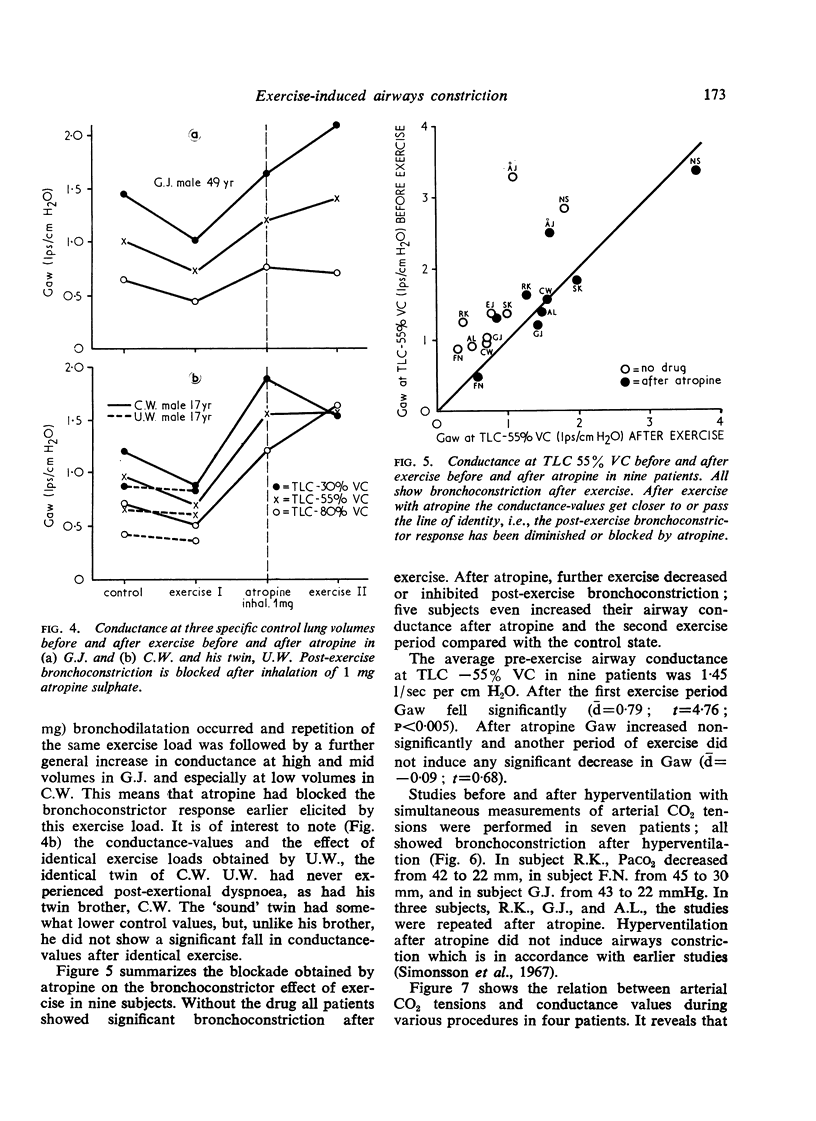
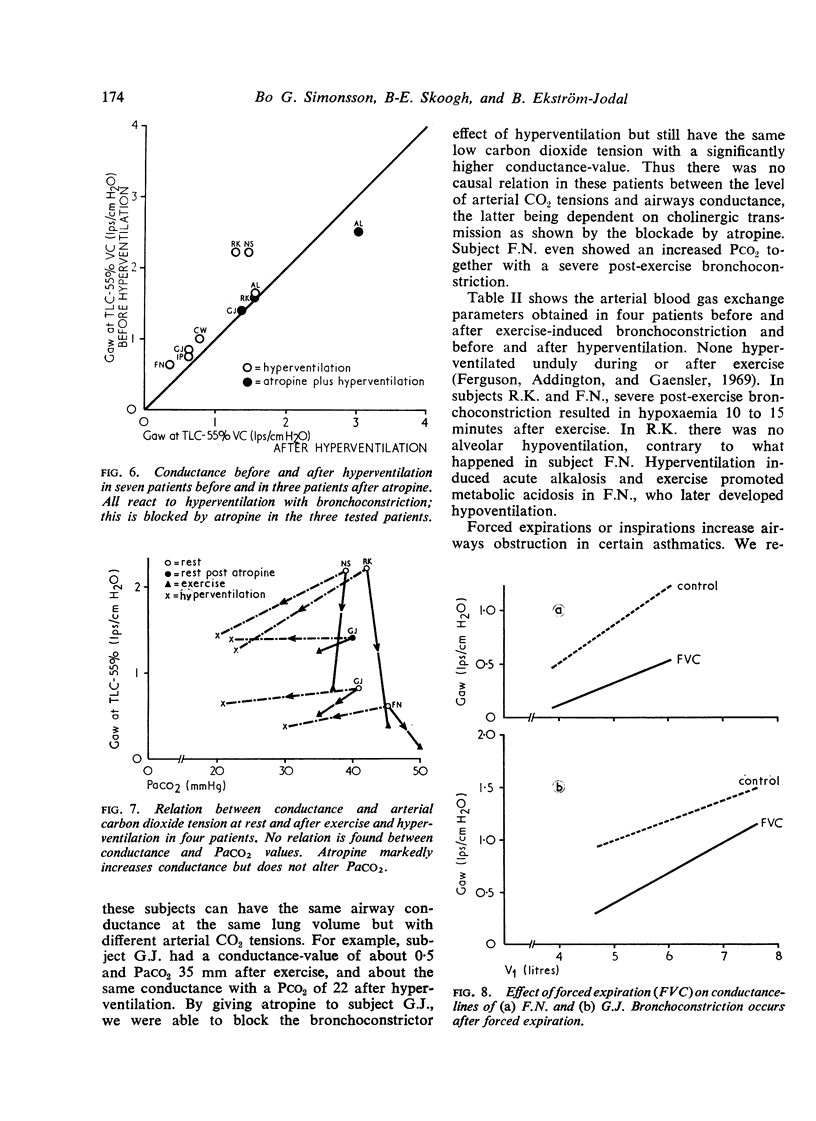
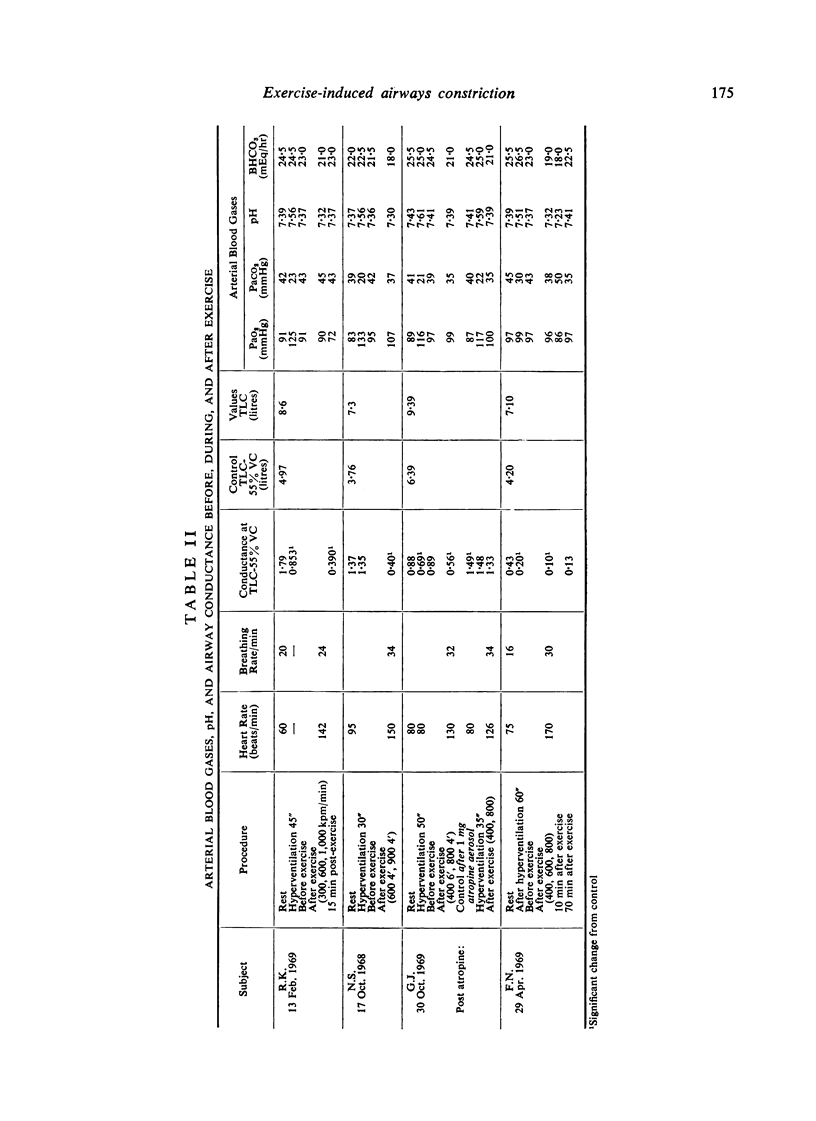
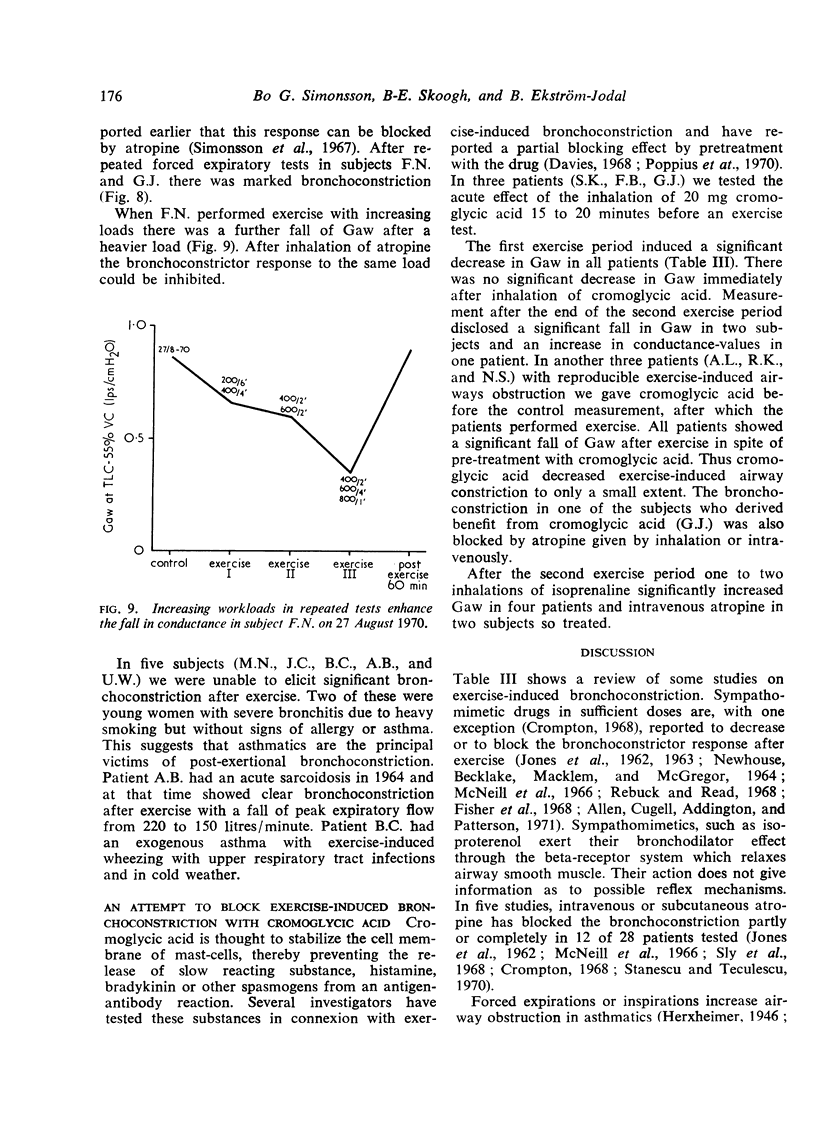
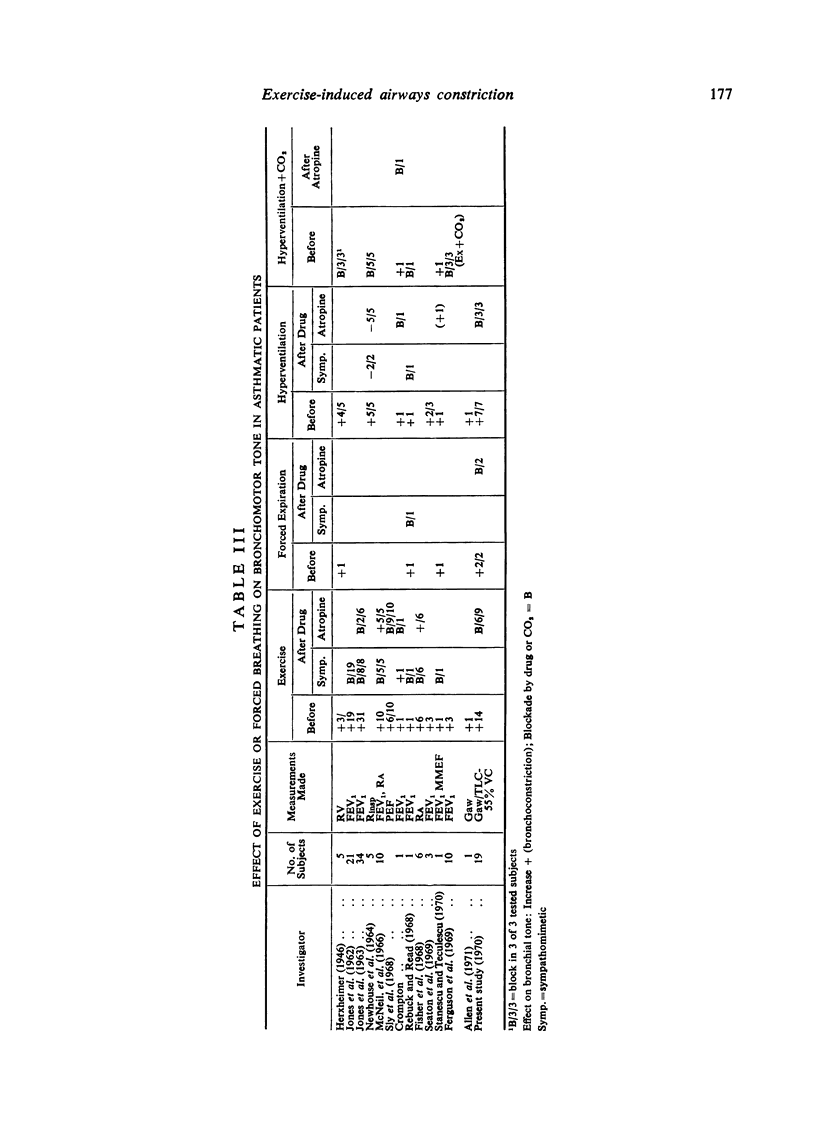
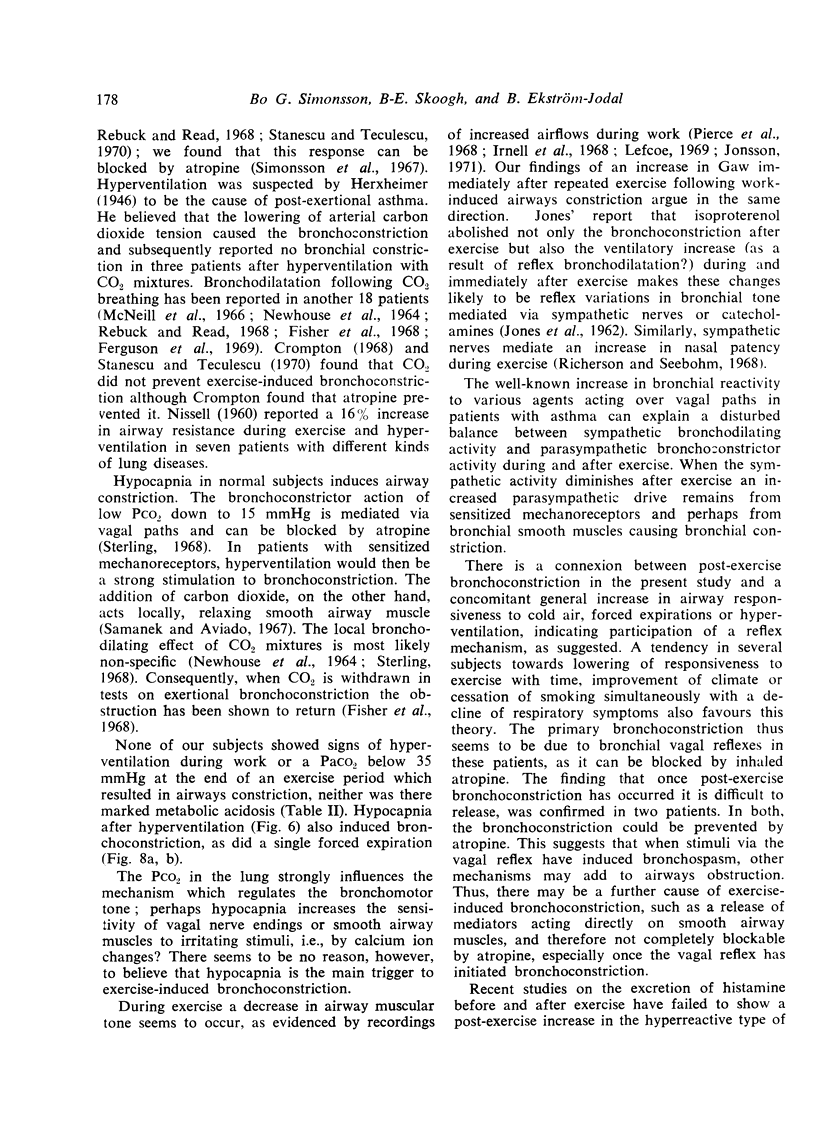
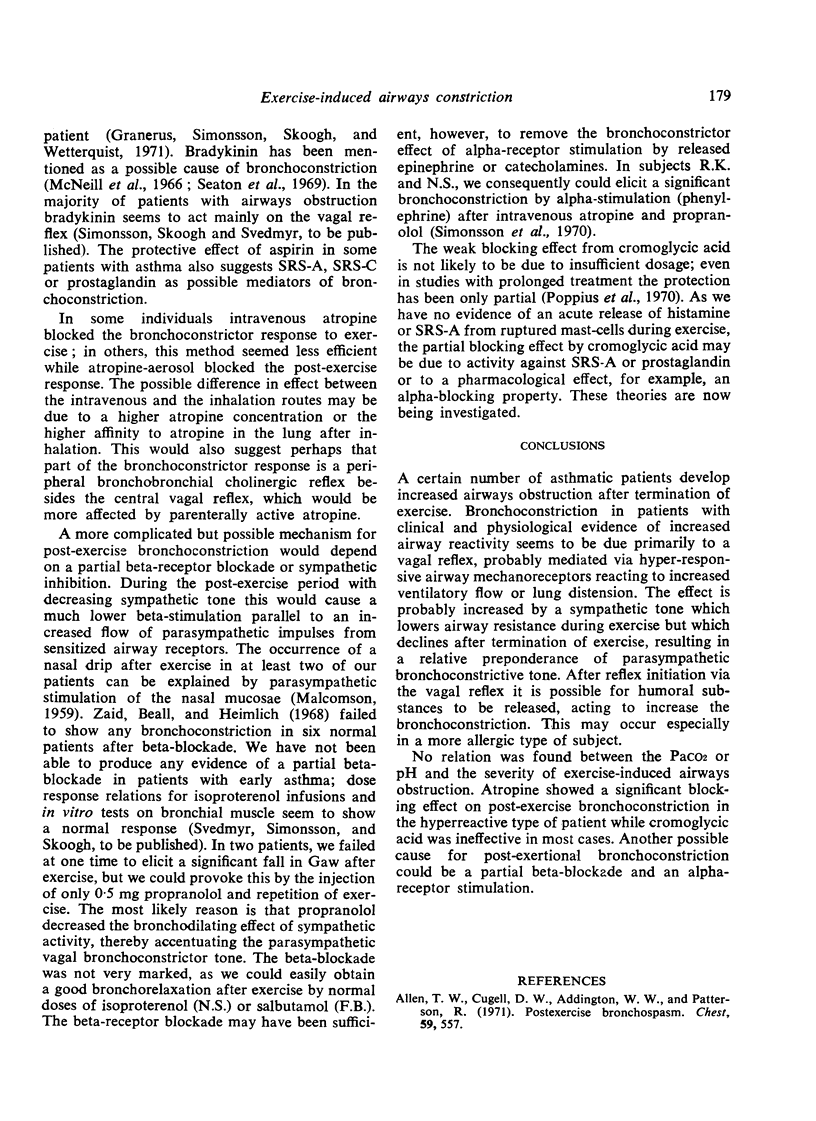
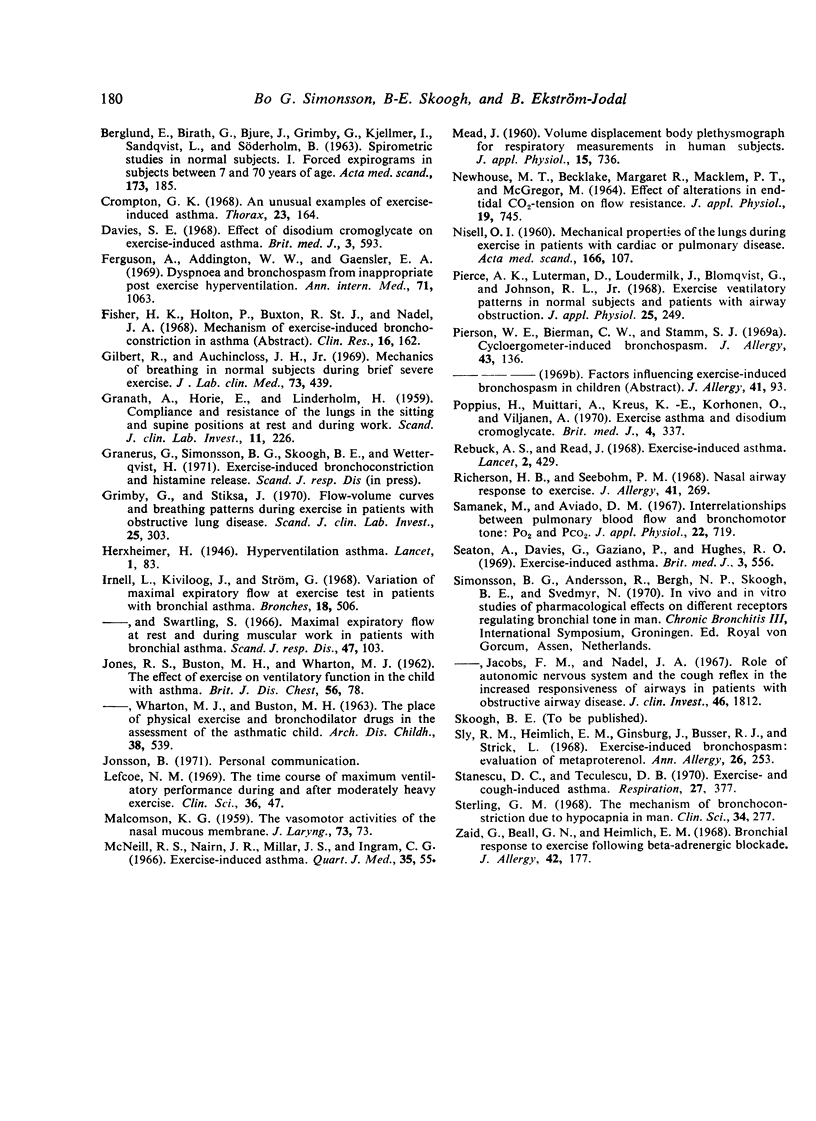
Selected References
These references are in PubMed. This may not be the complete list of references from this article.
- Allen T. W., Cugell D. W., Addington W. W., Patterson R. Postexercise bronchospasm. Clinical Conference in Pulmonary Disease from Northwestern University Medical Center, Chicago. Chest. 1971 May;59(5):557–560. doi: 10.1378/chest.59.5.557. [DOI] [PubMed] [Google Scholar]
- BERGLUND E., BIRATH G., BJURE J., GRIMBY G., KJELLMER I., SANDQVIST L., SODERHOLM B. Spirometric studies in normal subjects. I. Forced expirograms in subjects between 7 and 70 years of age. Acta Med Scand. 1963 Feb;173:185–192. [PubMed] [Google Scholar]
- Davies S. E. Effect of disodium cromoglycate on exercise-induced asthma. Br Med J. 1968 Sep 7;3(5618):593–594. doi: 10.1136/bmj.3.5618.593. [DOI] [PMC free article] [PubMed] [Google Scholar]
- Ferguson A., Addington W. W., Gaensler E. A. Dyspnea and bronchospasm from inappropriate postexercise hyperventilation. Ann Intern Med. 1969 Dec;71(6):1063–1072. doi: 10.7326/0003-4819-71-6-1063. [DOI] [PubMed] [Google Scholar]
- GRANATH A., HORIE E., LINDERHOLM H. Compliance and resistance of the lungs in the sitting and supine positions at rest and during work. Scand J Clin Lab Invest. 1959;11:226–234. doi: 10.3109/00365515909060441. [DOI] [PubMed] [Google Scholar]
- Gilbert R., Auchincloss J. H., Jr Mechanics of breathing in normal subjects during brief, severe exercise. J Lab Clin Med. 1969 Mar;73(3):439–450. [PubMed] [Google Scholar]
- Grimby G., Stiksa J. Flow-volume curves and breathing patterns during exercise in patients with obstructive lung disease. Scand J Clin Lab Invest. 1970 May;25(3):303–313. doi: 10.3109/00365517009046210. [DOI] [PubMed] [Google Scholar]
- Herxheimer H. Skin sensitivity to flour in bakers' apprentices. Lancet. 1967 Jan 14;1(7481):83–84. doi: 10.1016/s0140-6736(67)92479-8. [DOI] [PubMed] [Google Scholar]
- Irnell L., Kiviloog J., Ström G. Variation of maximal expiratory flow at exercise test in patients with bronchial asthma. Bronches. 1968 Nov-Dec;18(6):506–509. [PubMed] [Google Scholar]
- Irnell L., Swartling S. Maximal expiratory flow at rest and during muscular work in patients with bronchial asthma. Scand J Respir Dis. 1966;47(2):103–113. [PubMed] [Google Scholar]
- JONES R. S., BUSTON M. H., WHARTON M. J. The effect of exercise on ventilatory function in the child with asthma. Br J Dis Chest. 1962 Apr;56:78–86. doi: 10.1016/s0007-0971(62)80005-9. [DOI] [PubMed] [Google Scholar]
- JONES R. S., WHARTON M. J., BUSTON M. H. THE PLACE OF PHYSICAL EXERCISE AND BRONCHODILATOR DRUGS IN THE ASSESSMENT OF THE ASTHMATIC CHILD. Arch Dis Child. 1963 Dec;38:539–545. doi: 10.1136/adc.38.202.539. [DOI] [PMC free article] [PubMed] [Google Scholar]
- Lefcoe N. M. The time course of maximum ventilatory performance during and after moderately heavy exercise. Clin Sci. 1969 Feb;36(1):47–52. [PubMed] [Google Scholar]
- MALCOMSON K. G. The vasomotor activities of the nasal mucous membrane. J Laryngol Otol. 1959 Feb;73(2):73–98. doi: 10.1017/s0022215100054980. [DOI] [PubMed] [Google Scholar]
- McNeill R. S., Nairn J. R., Millar J. S., Ingram C. G. Exercise-induced asthma. Q J Med. 1966 Jan;35(137):55–67. [PubMed] [Google Scholar]
- NEWHOUSE M. T., BECKLAKE M. R., MACKLEM P. T., MCGREGOR M. EFFECT OF ALTERATIONS IN END-TIDAL CO2 TENSION ON FLOW RESISTANCE. J Appl Physiol. 1964 Jul;19:745–749. doi: 10.1152/jappl.1964.19.4.745. [DOI] [PubMed] [Google Scholar]
- NISELL O. Mechanical properties of the lungs during exercise in patients with cardiac or pulmonary disease. Acta Med Scand. 1960 Feb 17;166:107–112. doi: 10.1111/j.0954-6820.1960.tb17359.x. [DOI] [PubMed] [Google Scholar]
- Pierce A. K., Luterman D., Loudermilk J., Blomqvist G., Johnson R. L., Jr Exercise ventilatory patterns in normal subjects and patientws with airway obstruction. J Appl Physiol. 1968 Sep;25(3):249–254. doi: 10.1152/jappl.1968.25.3.249. [DOI] [PubMed] [Google Scholar]
- Pierson W. E., Bierman C. W., Stamm S. J. Cycloergometer-induced bronchospasm. J Allergy. 1969 Mar;43(3):136–144. doi: 10.1016/s0021-8707(69)80004-3. [DOI] [PubMed] [Google Scholar]
- Poppius H., Muittari A., Kreus K. E., Korhonen O., Viljanen A. Exercise asthma and disodium cromoglycate. Br Med J. 1970 Nov 7;4(5731):337–339. doi: 10.1136/bmj.4.5731.337. [DOI] [PMC free article] [PubMed] [Google Scholar]
- Rebuck A. S., Read J. Exercise-induced asthma. Lancet. 1968 Aug 24;2(7565):429–431. doi: 10.1016/s0140-6736(68)90468-6. [DOI] [PubMed] [Google Scholar]
- Richerson H. B., Seebohm P. M. Nasal airway response to exercise. J Allergy. 1968 May;41(5):269–284. doi: 10.1016/0021-8707(68)90032-4. [DOI] [PubMed] [Google Scholar]
- Samanek M., Aviado D. M. Interrelationships between pulmonary blood flow and bronchomotor tone: Po2 and Pco2. J Appl Physiol. 1967 Apr;22(4):719–730. doi: 10.1152/jappl.1967.22.4.719. [DOI] [PubMed] [Google Scholar]
- Seaton A., Davies G., Gaziano D., Hughes R. O. Exercise-induced asthma. Br Med J. 1969 Sep 6;3(5670):556–558. doi: 10.1136/bmj.3.5670.556. [DOI] [PMC free article] [PubMed] [Google Scholar]
- Simonsson B. G., Jacobs F. M., Nadel J. A. Role of autonomic nervous system and the cough reflex in the increased responsiveness of airways in patients with obstructive airway disease. J Clin Invest. 1967 Nov;46(11):1812–1818. doi: 10.1172/JCI105671. [DOI] [PMC free article] [PubMed] [Google Scholar]
- Sly R. M., Heimlich E. M., Ginsburg J., Busser R. J., Strick L. Exercise-induced bronchospasm: evaluation of metaproterenol. Ann Allergy. 1968 May;26(5):253–258. [PubMed] [Google Scholar]
- Stanescu D. C., Teculescu D. B. Exercise- and cough-induced asthma. Respiration. 1970;27(4):377–383. doi: 10.1159/000192694. [DOI] [PubMed] [Google Scholar]
- Sterling G. M. The mechanism of bronchoconstriction due to hypocapnia in man. Clin Sci. 1968 Apr;34(2):277–285. [PubMed] [Google Scholar]


